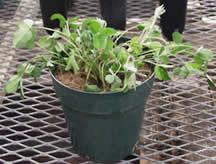Stimulation of Sporulation
Propagation Cycles
A significant number of cultures will begin to show reduced sporulation after repeated propagation cycles. Records suggest that this can occur after four or more successive generations (even with prolonged storage between cycles). The reasons are unclear, but two behaviors are apparent: (i) a weakening in colonization of roots concurrent with formation of fewer spores or (ii) maintenance of colonization, but with fewer spores produced. The former may be a loss of compatibility with the existing host or a loss of vigor by the fungus. The latter may be a change in partitioning of carbon to sporulation versus colonization. Since we cannot modify the fungus, the only other two options are to change the host plant or change culture environment.
Change in Host Species
Our standard host is the highly mycotrophic warm-season small grain, sudangrass. When sporulation declines, our first step is to reseed the culture in case ambient conditions caused the problem. If sporulation still is low after this propagation cycle, then we reseed again, but with a different host species. Anecdotal evidence from efforts at this over the past decade suggests that a dramatic “jump-start” requires choice of a completely unrelated species to sudangrass and relatives (including other warm-season grasses). The most frequent recovery from attenuation has occurred with a mycotrophic C3 legume, red clover ( Trifolium pratense).

Other clovers such as alfalfa, birdsfoot trefoil, peanut, etc. may be equally effective, but we have not tested them and therefore cannot draw conclusions. All of these species have a high P requirement for nitrogenase activity in nodules, so mycorrhizal dependency will be high with little constraint on colonization potential. It is important to keep in mind that rate of sporulation will vary greatly with each of these legume species until they have grown sufficiently to cease root growth (which also will depend on seeding rate and greenhouse environment). To approximate sporulation expected with sudangrass, we sample pots for spores 30 days after plant shoots have ceased to grow ( our hypothesis of why this occurs).
This approach also can be used in conjunction with transplanting, wherein the plant species seeded around the transplant is a different host.
Certain host species should be avoided, especially if the culture contains more than one species (and competition becomes a driving force in final productivity):
- Those with low dependency on the symbiosis—colonization is usually constrained, with concomitant low sporulation potential in most cases.
- Woody perennials—while highly mycotrophic (usually), there appears to be constraints imposed determinants of host-fungus compatibility. For example, the widely ubiquitous Claroideoglomus etunicatum grows well on legumes/grasses/small grains, it is slower to establish and sporulate on tree species such as apple and tulip poplar. When in a mixed population with Glomus intraradices (a highly compatible species with woody plants), C. etunicatum sporulation disappears.
Change in Culture Environment
This approach has not yielded any consistent pattern, and so we generally have avoided such manipulations. Changes in the growth medium or medium pH invariable inhibit fungal colonization and sporulation, probably because we are impacting on the primary infection phase so critical to later secondary spread. Increasing light conditions can greatly stimulates plant/root biomass production, but only sometimes does such a change bring a fungus out of attenuation (unless it is accompanied by a change in host species).